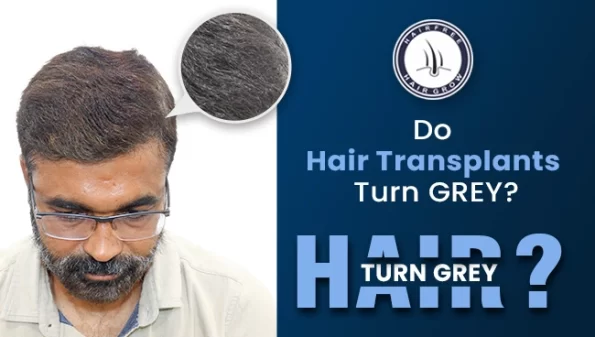Hair transplant is a popular cosmetic surgery that is performed to restore hair growth in areas where there is thinning or balding. While the procedure can be successful in most cases, some individuals have expressed concerns about whether the transplanted hair will turn grey over time. In this blog, we will explore the factors that contribute to hair graying and whether hair transplants can turn grey. Do hair transplants turn grey? Yes, they can, just like your natural hair.
Why Does Hair Turn Grey?
Hair turns grey because of a decrease in melanin production. Melanin is the pigment responsible for the color of our hair. As we age, the melanocytes, the cells that produce melanin, become less efficient in producing melanin. This results in less melanin being deposited into the hair shafts, leading to a loss of color and the hair appearing grey or white.
The exact cause of why melanin production decreases with age is not fully understood, but it is believed to be a combination of genetic, environmental, and cellular factors. Genetics play a significant role in determining when an individual’s hair will turn grey, as it is often hereditary. Other factors such as oxidative stress, accumulation of hydrogen peroxide in the hair follicles, and inflammation may also contribute to the decrease in melanin production.
Additionally, lifestyle and diet may play a role in the greying of hair. Poor nutrition, stress, smoking, and exposure to environmental pollutants may accelerate the greying process. Certain medical conditions, such as vitiligo and thyroid disorders, may also affect melanin production and contribute to premature greying of hair.
Other Factors That Contribute to Hair Graying
Apart from aging, several other factors can contribute to hair graying. Here are some of the most common ones:
Genetics
Genetics play a significant role in determining when hair starts to gray. If your parents or grandparents began graying at a young age, you’re more likely to do so too.
Stress
Excessive stress can damage hair follicles, leading to premature graying.
Vitamin Deficiency
A deficiency in certain vitamins, such as vitamin D, can lead to premature graying.
Smoking
Smoking can damage the DNA in hair follicles, leading to premature graying.
Medical Conditions
Certain medical conditions, such as thyroid disorders and vitiligo, can cause premature graying.
Managing Grey Transplanted Hair
Although transplanted hair is not immune to greying, there are ways to manage and minimize the impact of grey hair on the results of a hair transplant:
Proper Hair Care
Following a proper hair care routine, including regular washing, conditioning, and moisturizing, can help maintain the health and appearance of transplanted hair, even if it turns grey.
Nutrition
A well-balanced diet rich in essential vitamins and minerals, such as biotin, zinc, and vitamin E, can promote healthy hair growth and delay the greying process.
Avoiding Smoking and Excessive Sun Exposure
Smoking and prolonged sun exposure can accelerate the aging process of hair, including transplanted hair. Avoiding these habits can help maintain the color and health of the transplanted hair.
Consultation with a Hair Specialist
Regular follow-ups with a hair specialist or surgeon who performed the hair transplant can help monitor the progress of the transplanted hair and provide appropriate recommendations for managing grey hair.
Do Hair Transplants Turn Grey?
Now that we understand the factors that contribute to hair graying let’s explore whether hair transplants can turn grey. The short answer is yes, transplanted hair can turn grey just like the rest of your hair. However, it’s important to note that hair transplants don’t cause hair to turn grey. The reason for this is that the transplanted hair retains its genetic properties, including how it will respond to aging.
In other words, if you’re genetically predisposed to premature graying, the transplanted hair will also turn grey at the same rate as your natural hair. Similarly, if your natural hair doesn’t gray until later in life, the transplanted hair will also follow the same pattern.
It’s also essential to note that hair transplant surgeons typically harvest hair from areas where hair is unlikely to turn grey, such as the sides and back of the head. This ensures that the transplanted hair maintains its color for longer.
One thing to keep in mind is that hair transplant surgery is not a permanent solution to hair loss. While the transplanted hair will continue to grow, the existing natural hair may continue to fall out due to underlying factors such as genetics or medical conditions. As a result, it’s essential to manage your expectations and discuss any concerns with your hair transplant surgeon.
Conclusion
Hair transplant surgery is a popular cosmetic procedure that can help restore hair growth in areas where there is thinning or balding. While the procedure itself does not cause hair to turn grey, the transplanted hair will eventually follow the same graying pattern as your natural hair. To ensure the best possible outcome, it’s crucial to choose an experienced hair transplant surgeon who can guide you through the entire process and manage your expectations. If you have concerns about whether hair transplants can turn grey, speak to your surgeon, who can provide you with more information based on your specific situation.
Written By
MD (Skin & VD)
Dr Kiran Chotaliya is leading hair plantation surgeon in India. He has ample experience in dealing with hair transplant turning grey and has successfully recovered many patients suffering from the same.
Disclaimer
We’ve made all possible efforts to ensure that the information provided here is accurate, up-to-date and complete, however, it should not be treated as a substitute for professional medical advice, diagnosis or treatment. See Detailed Disclaimers Here.



